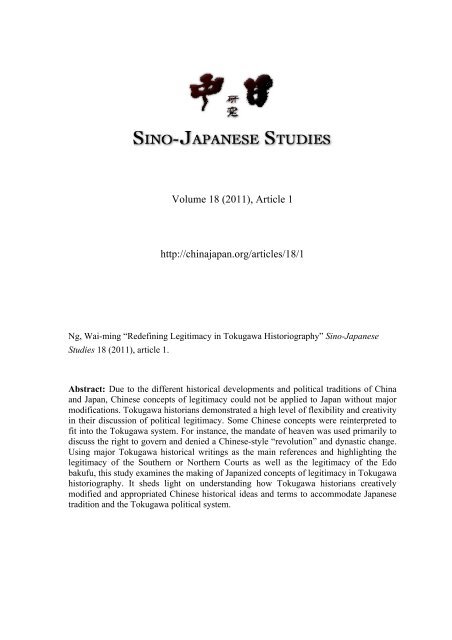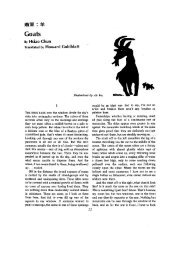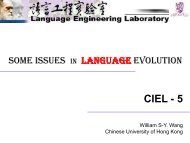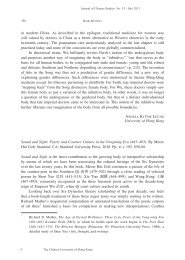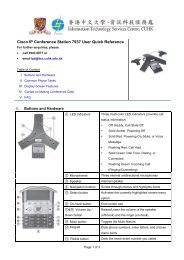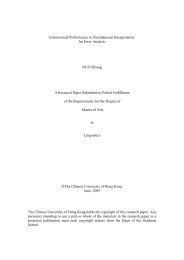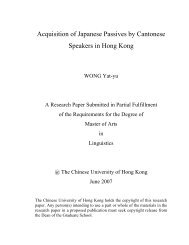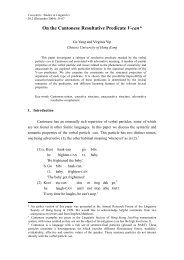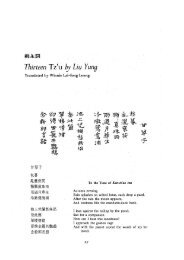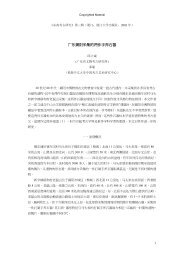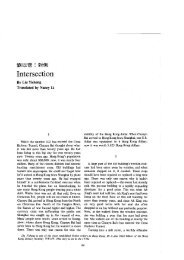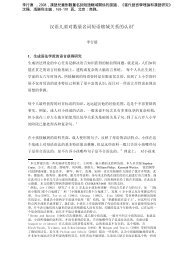Close - Sino-Japanese Studies
Close - Sino-Japanese Studies
Close - Sino-Japanese Studies
Create successful ePaper yourself
Turn your PDF publications into a flip-book with our unique Google optimized e-Paper software.
Volume 18 (2011), Article 1<br />
http://chinajapan.org/articles/18/1<br />
Ng, Wai-ming “Redefining Legitimacy in Tokugawa Historiography” <strong>Sino</strong>-<strong>Japanese</strong><br />
<strong>Studies</strong> 18 (2011), article 1.<br />
Abstract: Due to the different historical developments and political traditions of China<br />
and Japan, Chinese concepts of legitimacy could not be applied to Japan without major<br />
modifications. Tokugawa historians demonstrated a high level of flexibility and creativity<br />
in their discussion of political legitimacy. Some Chinese concepts were reinterpreted to<br />
fit into the Tokugawa system. For instance, the mandate of heaven was used primarily to<br />
discuss the right to govern and denied a Chinese-style “revolution” and dynastic change.<br />
Using major Tokugawa historical writings as the main references and highlighting the<br />
legitimacy of the Southern or Northern Courts as well as the legitimacy of the Edo<br />
bakufu, this study examines the making of Japanized concepts of legitimacy in Tokugawa<br />
historiography. It sheds light on understanding how Tokugawa historians creatively<br />
modified and appropriated Chinese historical ideas and terms to accommodate <strong>Japanese</strong><br />
tradition and the Tokugawa political system.
<strong>Sino</strong>-<strong>Japanese</strong> <strong>Studies</strong> http://chinajapan.org/articles/18/1<br />
Introduction<br />
Redefining Legitimacy in Tokugawa Historiography<br />
Wai-ming Ng<br />
Chinese University of Hong Kong<br />
Both the Chinese and the <strong>Japanese</strong> have a tradition of compiling and using history.<br />
Chinese historical writings, in particular, Sima Guang’s 司馬光 (1019-1086) Zizhi<br />
tongjian 資治通鑑 (Comprehensive Mirror for Aid in Government, 1084) and Zhu Xi’s<br />
朱熹 (1130-1200) Tongjian gangmu 通鑑綱目 (Summary of the Comprehensive<br />
Mirror, 1172), were also influential in shaping historical critique and terminology in<br />
<strong>Japanese</strong> historiography. Legitimizing the current regime was a hidden political agenda in<br />
many historical writings in China and Japan in which the discussion of political<br />
“legitimacy” (正統 zhengtong in Chinese, seitō in <strong>Japanese</strong>) was passionately engaged.<br />
At a glance, the discourse on political legitimacy looks similar in Chinese and <strong>Japanese</strong><br />
historical writings, as both laid emphasis on the blood lineage and morality in the fashion<br />
of Chunqiu 春秋 (Spring and Autumn Annals) and the Zhu Xi School. A virtuous ruler<br />
descending from the royal bloodline would be in a good position to contest legitimacy. A<br />
closer investigation reveals that Tokugawa historiography redefined and indigenized<br />
Chinese concepts of legitimacy to rationalize political realities in Tokugawa Japan, such<br />
as the bakuhan 幕藩 system (the Tokugawa political structure that defined the<br />
relationship between the shogunate and domains), the authority of the Edo bakufu, the<br />
co-existence of two central governments, and the political implications of Shinto.<br />
The writing of history in Japan reached its peak in the Tokugawa period. The<br />
bakufu cultivated Ieyasu’s cult through the compilation of official histories and the<br />
1
<strong>Sino</strong>-<strong>Japanese</strong> <strong>Studies</strong> http://chinajapan.org/articles/18/1<br />
establishment of the Tōshōgū Shrine 東照宮. 1 The first Edo shogun, Tokugawa Ieyasu<br />
德川家康 (1543-1616), was presented as a sage ruler and a deity. In the seventeenth<br />
century, <strong>Japanese</strong> historians were preoccupied with the idea of legitimizing the<br />
newly-founded regime. 2 The three representative Tokugawa historical writings—namely,<br />
Honchō tsugan 本朝通鑑 (Comprehensive Mirror of Japan, 1670, written by Hayashi<br />
Razan 林羅山 [1583-1657] and his son, Gahō 鵞峰[1618-1680]), Dai Nihon shi 大日<br />
本史 (History of Great Japan, 1657-1906, compiled by Tokugawa Mitsukuni 德川光圀<br />
[1628-1700]), and Tokushi yoron 讀史餘論 (A Reading of History, 1712, written by<br />
Arai Hakuseki 新井白石 [1657-1725])—all agreed that Emperor Go-Daigo 後醍醐天<br />
皇 (1288-1339) split the nation in two and thus lost legitimacy to rule, and that<br />
Tokugawa Ieyasu received the heaven’s mandate (tenmei 天命) to rule by virtue of his<br />
high moral standard and military abilities. Using major Tokugawa historical writings as<br />
the main references and highlighting the legitimacy of the Southern-Northern Courts and<br />
the legitimacy of the Edo bakufu, this study examines the making of Japanized concepts<br />
of legitimacy in Tokugawa historiography. It sheds light on understanding how<br />
Tokugawa historians creatively modified and appropriated Chinese historical ideas and<br />
terms to accommodate <strong>Japanese</strong> tradition and the Tokugawa political system.<br />
The Limitation of Chinese Concepts of Legitimacy in <strong>Japanese</strong> History<br />
Political legitimacy in Chinese historiography was a complicated concept<br />
intricately intertwined with morality, unification, the distinction between the Han and<br />
barbarians (華夷之辨 huayi zhi bian), blood lineage, transmission of the sagely way (道<br />
1<br />
Herman Ooms, Tokugawa Ideology: Early Constructs, 1570-1680 (Princeton: Princeton<br />
University Press, 1985), pp. 50-62.<br />
2<br />
Victor Koschmann, The Mito Ideology: Discourse, Reform, and Insurrection in Late Tokugawa<br />
Japan, 1790-1864 (Berkeley: University of California Press, 1987), p. 45.<br />
2
<strong>Sino</strong>-<strong>Japanese</strong> <strong>Studies</strong> http://chinajapan.org/articles/18/1<br />
統 daotung), five circulatory phases (五運 wuyun), and heaven’s mandate. 3 Unlike<br />
their Chinese counterparts, <strong>Japanese</strong> historical writings used neither the distinction<br />
between the Han and barbarians, the five circulatory phases, nor the transmission of the<br />
sagely way. In order to legitimize the Tokugawa system, <strong>Japanese</strong> historians created their<br />
own theories of legitimacy (such as the imperial regalia theory) and modified Chinese<br />
concepts (such as heaven’s mandate).<br />
The distinction between the Han and barbarians was applied to discuss the<br />
legitimacy of regimes founded by non-Han peoples. When there was a coexistence of<br />
Han regime and non-Han regime in China, the former had a better chance to be regarded<br />
as legitimate. Non-Han regimes, unless they could unify the nation, such as the Mongol<br />
Yuan Dynasty and the Manchu Qing Dynasty, were seldom considered legitimate. 4<br />
This doctrine was not applicable to pre-modern Japan that had never been conquered by<br />
foreign nations. The Koreans, Chinese, Ryukyuan, and Ainu were largely assimilated into<br />
the Yamato race-dominated Japan. The sense of racial superiority did exist in Tokugawa<br />
historical writings. For instance, Dai Nihon shi put China, Korea, Ezo 蝦夷, the Bohai<br />
Kingdom 渤海國, and Southeast Asia under the category of “Shohan retsuden” 諸藩列<br />
傳 (J. Zhufan liezhuan, “Biographies of Foreign Nations”). It was only a nationalist<br />
expression and was not used to discuss legitimacy in <strong>Japanese</strong> history.<br />
3 Rao Zongyi (Jao Tsung-I) 饒宗頤, Zhongguo shixue shang zhi zhengtonglun 中國史學上之<br />
正統論 (Legitimacy in Chinese Historiography) (Hong Kong: Longmen shudian, 1977).<br />
4 Unification and legitimacy are closely tied. See Yuri Pines, “Name or Substance Between<br />
Zhengtong and Yitong,” History: Theory and Criticism 2 (May 2001): 105-38. The internal<br />
conflict between unification and legitimacy can be seen from Zhu Xi’s disagreement with Sima<br />
Guang over the Three Kingdoms. While Sima Guang regarded Wei as the legitimate regime<br />
because it was responsible for finally unifying the nation, Zhu Xi claimed legitimacy for Shu<br />
because of its proper bloodline and righteous motives. See Naitō Konan 內藤湖南, “Cong<br />
Songdai shixue kan Zhongguo zhengtong lun” 從宋代史學看中國正統論 (Legitimacy in China<br />
as seen from Song Historiography), trans. Ng Wai-ming 吳偉明, History: Theory and Criticism<br />
2 (May 2001): 161-67.<br />
3
<strong>Sino</strong>-<strong>Japanese</strong> <strong>Studies</strong> http://chinajapan.org/articles/18/1<br />
The theory of five circulatory phases had been influential in the discussion of<br />
political legitimacy in China from the Qin-Han era through the Tang-Song, using the<br />
doctrines of wude zhongshi 五德終始 (the rotation of the five virtues) and wuxing<br />
xiangsheng xiangke 五行相生相剋 (mutual creation and destruction of the five agents)<br />
to argue that dynastic change was historically inevitable. 5 Introduced to Japan in<br />
ancient times, this theory was mainly applied to astronomy, geography, medicine,<br />
military and divination. In politics, it only exerted influence on matters of secondary<br />
importance such as revising the calendar in the sixty-year cycle (甲子 jiazi) and was not<br />
applied to political legitimacy. 6 Although many Tokugawa historical writings contained<br />
the idea of historical trends or inevitability, they did not adopt the theory of five<br />
circulatory phases.<br />
The transmission of the sagely way was an important idea in Neo-Confucianism.<br />
According to this theory, when China was not unified, the regime that transmitted<br />
Confucian orthodoxy was legitimate. Hence, many scholars of the Zhu Xi School claimed<br />
legitimacy for Shu and Southern Song on the basis of morality. Some Tokugawa<br />
Confucian scholars suggested that the transmission of the sagely way shifted from China<br />
to Japan. 7 Yamaga Sokō 山鹿素行 (1622-1685), in his Chūchō jijitsu 中朝事實 (The<br />
True Facts Concerning the Central Kingdom, 1669), referred to China as “Shina 支那”,<br />
“gaichō” 外朝 (foreign nation), and “ichō” 異朝 (alien nation). He maintained that<br />
China lost the transmission of the sagely way to Japan due to dynastic change and foreign<br />
invasion, and thus only Japan, the land of absolute loyalty, was entitled to use “chūchō”<br />
5<br />
Gu Jiegang 顧頡剛, Wude zhongshi shuo xia de zhengzhi he lishi 五德終始說下的政治和歷<br />
史 (Politics and History under the Doctrine of the Rotation of the Five Virtues) (Hong Kong:<br />
Longmen shudian, 1970).<br />
6<br />
Wai-ming Ng, The I Ching in Tokugawa Thought and Culture (Honolulu: University of<br />
Hawai‘i Press, 2000), Chapter 4.<br />
7<br />
Kate Nakai, “The Naturalization of Confucianism in Tokugawa Japan: The Problem of<br />
<strong>Sino</strong>centrism,” Harvard Journal of Asiatic <strong>Studies</strong> 40:1 (June 1980): 157-99.<br />
4
<strong>Sino</strong>-<strong>Japanese</strong> <strong>Studies</strong> http://chinajapan.org/articles/18/1<br />
中朝 (central kingdom), “chūshū” 中州 (central continent) and “chūka” 中華 (central<br />
land). Mito scholars Tokugawa Mitsukuni and Aizawa Seishisai 會澤正志齋<br />
(1781-1863) aired similar views. Sokō, Mitsukuni, and Seishisai discussed the<br />
transmission of the sagely way from a cross-cultural perspective; none applied it to<br />
political legitimacy in <strong>Japanese</strong> history.<br />
Blood lineage was a useful means to claim legitimacy in China. Insurrectionists<br />
and new emperors liked to claim to carry noble blood and to emphasis their Han identity<br />
(in case the overthrown regime was non-Han). In Japan, blood lineage was applied to<br />
legitimize the authority to govern, and not sovereignty itself. De facto rulers of Japan,<br />
including courtiers, imperial relatives, and warriors, gained prestige and authority from<br />
their alleged noble origins. Like their Chinese counterparts, for the sake of political<br />
justification, the <strong>Japanese</strong> forged a large number of family histories and historical sources.<br />
The early Tokugawa was the heyday of forgery when the bakufu and domains strove to<br />
establish their legitimacy through problematic genealogies. 8 Matsudaira 松平 (later<br />
renamed Tokugawa), a military clan of Mikawa Province 三河國 from the Kantō 關東<br />
region, claimed descent from the Seiwa Genji 清和源氏, one of the most powerful<br />
branches in the Minamoto clan. Seiwa Genji was the most prestige family among the<br />
warriors. The founder of the three military regimes—namely, Minamoto no Yoritomo 源<br />
頼朝 (1147-1199), Ashikaga Takauji 足利尊氏 (1305-1358), and Tokugawa<br />
Ieyasu—all claimed descent from this lineage. There was a saying, “non-Seiwa Genji<br />
cannot be appointed Shogun.” There were exceptions in <strong>Japanese</strong> history, but the<br />
influence of Seiwa Genji in the medieval and early modern periods was undoubtedly<br />
strong. Tokugawa Ieyasu already called himself “Minamoto Ason” 源朝臣 prior to the<br />
8 Wai-ming Ng, “The Forgery of Books in Tokugawa Japan,” East Asian Library Journal 9.2<br />
(2000): 19-45.<br />
5
<strong>Sino</strong>-<strong>Japanese</strong> <strong>Studies</strong> http://chinajapan.org/articles/18/1<br />
founding of the Edo bakufu. Throughout the Tokugawa period, disputable blood ties<br />
between the Tokugawa and the Seiwa Genji became widely accepted. For instance, Rai<br />
Sanyō 賴山陽 (1781-1832), in his Nihon gaishi 日本外史 (An Unofficial <strong>Japanese</strong><br />
History, 1829), introduced the origins of the Tokugawa house as follows: “My Tokugawa<br />
clan was descended from Nitta Yoshishige 新田義重. Yoshishige was the<br />
eight-generation descendant of Emperor Seiwa 清和天皇. Tsunemoto 經基, the<br />
grandson of Emperor Seiwa, was granted the surname Minamoto and downgraded to a<br />
military house.” 9<br />
The Rise of <strong>Japanese</strong> Interpretation of Heaven’s Mandate<br />
Heaven’s mandate was a key concept in Chinese historical writings. Based on<br />
Confucian classics such as Mengzi 孟子 (Book of Mencius) and Yijing 易經 (Book of<br />
Changes), this concept constituted a political philosophy that fused morality, heaven’s<br />
will, and revolution. In the Chinese political tradition, the throne held sovereignty and<br />
carried out governance. When the incumbent emperor was morally handicapped, his<br />
heaven’s mandate would be taken away and given to another person to found a new<br />
dynasty by means of revolution. The doctrine of heaven’s mandate was a powerful<br />
ideology to justify dynastic change and legitimize new regime.<br />
<strong>Japanese</strong> historical writings used the concept of heaven’s mandate in a different<br />
manner. In <strong>Japanese</strong> history, the separation of sovereignty and governance was the norm.<br />
The imperial family reigned in unbroken succession but did not usually rule. Heaven’s<br />
mandate, in <strong>Japanese</strong> historical writings, except for a few cases, referred to the right to<br />
9 Rai Sanyō, Nihon gaishi, ed. Tsukamoto Tetsuzō 塚本哲三, Vol. 2, Chapter 18 (Tokyo:<br />
Yūhōdō, 1921), p. 555.<br />
6
<strong>Sino</strong>-<strong>Japanese</strong> <strong>Studies</strong> http://chinajapan.org/articles/18/1<br />
govern. 10 Tokugawa historians, perhaps with a few exceptions like Arai Hakuseki and<br />
Daizai Shundai 太宰春台 (1680-1747), discussed the political legitimacy of the Edo<br />
bakufu within the traditional political framework. 11<br />
The earlier form of the heaven’s mandate theory in Japan was heaven’s way<br />
(tendō 天道). Historical writings of the medieval and Warring States periods, such as<br />
Taiheiki 太平記 (Record of the Great Peace), Genpei seisuiki 源平盛衰記 (An<br />
Account of the Genpei Wars), Heike monogatari 平家物語 (The Tale of Heike), and<br />
Shinchō kōki 信長公記 (Chronicle of Lord Nobunaga), contained the idea of heaven’s<br />
way, showing that warrior families used heaven’s way to justify their ever increasing<br />
powers. According to the heaven’s way doctrine, heaven’s way was higher than secular<br />
powers including the imperial house. Warrior leaders claimed that their powers came<br />
from heaven and not the imperial house. Hence, the heaven’s way doctrine undermined<br />
the authority of the imperial house. 12 In the Warring States period, warrior leaders<br />
began to use both heaven’s way and heaven’s mandate in their writings, claiming that<br />
they received heaven’s mandate to carry out heaven’s way.<br />
In the Tokugawa period, the theory of heaven’s mandate was frequently used in<br />
historical writings to legitimize the bakufu as the de facto central government. Both<br />
official and unofficial histories agreed that Tokugawa Ieyasu received the heaven’s<br />
mandate to govern the nation. Honchō tsugan, Tokushi yoron and Dai Nihon shi all<br />
pointed out that Emperor Go-Daigo lost the heaven’s mandate to the warrior house due to<br />
10<br />
John Tucker, “Two Mencian Political Notions in Tokugawa Japan,” Philosophy East and West<br />
47.2 (April 1997): 233-53.<br />
11<br />
Arai Hakusei regarded the Edo bakufu as a new dynasty that combined sovereignty and<br />
governance, a position close to the Chinese definition of “revolution.” Daizai Shundai insisted<br />
that the Kamakura bakufu, Muromachi bakufu and Edo bakufu were all independent dynasties<br />
and that the shogun should carry the title of “King of Japan.” Theirs were nevertheless an<br />
alternative view.<br />
12<br />
Ozawa Eiichi 小澤榮一, Kinsei shigaku shisō shi kenkyū 近世史学思想史研究 (A Study of<br />
Ideas in Early Modern <strong>Japanese</strong> Historiography) (Tokyo: Yoshikawa kōbunkan, 1974), pp. 15-17.<br />
7
<strong>Sino</strong>-<strong>Japanese</strong> <strong>Studies</strong> http://chinajapan.org/articles/18/1<br />
his ethical failures. 13 The three representative Tokugawa historical writings, based on<br />
Ieyasu’s morality, ability, bloodline and achievement of unification, confirmed that he<br />
received the heaven’s mandate. The Hayashi family compared the Battle of Sekigahara to<br />
“the righteous uprisings of King Tang of Shang and King Wu of Zhou.” Arai Hakuseki,<br />
in his Hankanpu 藩翰譜 (The Genealogies of Daimyō, 1702), used “a change in<br />
heaven’s mandate” (tenmei ikkai 天命一改) to refer to Ieyasu’s victory at the Battle of<br />
Sekigahara. In Tokushi yoron, Hakuseki divided <strong>Japanese</strong> history into fourteen epochs,<br />
representing the frequent change in heaven’s mandate. Ironically, the same theory of<br />
heaven’s mandate made an opposite turn in the bakumatsu 幕末 period (late Tokugawa<br />
era, 1853-1867), used by loyalists (shishi 志士) to express anti-bakufu views. For<br />
instance, Yoshida Shōin 吉田松陰 (1830-1859) believed that the bakufu lost heaven’s<br />
mandate for failing to carry out the policy of “revere the emperor and repel the<br />
barbarians” (sonnō jōi 尊王攘夷).<br />
The Southern and Northern Courts Controversy over Legitimacy<br />
<strong>Japanese</strong> historiography reached its apex in the Tokugawa period when the<br />
bakufu, domains, and independent scholars were enthusiastic about history writing and<br />
critique. There were two major issues about legitimacy in Tokugawa historical writings:<br />
the Southern and Northern courts controversy and the legitimacy of the Edo bakufu,<br />
addressing sovereignty and governance respectively.<br />
13 Although Dai Nihon shi appreciated Emperor Do-Daigo’s efforts in the Kenmu Restoration 建<br />
武中興 (1333-1336), it blamed him for making politics chaotic and for losing the mandate of<br />
heaven. It reads: “[Ashikaga] Takauji was full of disloyal acts, but they were caused by the<br />
collapse of imperial rule.” See Asaka Tanpaku 安積澹泊, Dai Nihon shi sansō 大日本史賛藪<br />
(Appraisal of the Dai Nihon shi), in Matsumoto Sannosuke 松井三之介 and Ogura Yoshihiko<br />
小倉芳彥, annot., Nihon shisō taikei 日本思想大系 48: Kinsei shi ronshū 近世史論集<br />
(Collection of Early Modern Historical Writings) (Tokyo: Iwanami shoten, 1974), p. 297.<br />
8
<strong>Sino</strong>-<strong>Japanese</strong> <strong>Studies</strong> http://chinajapan.org/articles/18/1<br />
The era of nanbokuchō 南北朝 (Southern and Northern Courts, 1336-1392) was<br />
the only period in <strong>Japanese</strong> history that had two rivaling dynasties; each had its own<br />
imperial house, central government, army, land, and people. It was not easy for the<br />
bakufu to handle this issue. From the perspective of the regime’s unification and the<br />
current imperial bloodline, the Northern Court should have been legitimate. Judging from<br />
morality and the blood ties with the Tokugawa house, it was the Southern Court that<br />
should have been legitimate. The bakufu declared the Northern Court the legitimate<br />
regime, and official writings, ceremonies, and rituals basically followed this position.<br />
Nevertheless, a certain level of ambiguity remained. The bakufu never imposed this<br />
official stance on the Tokugawa intellectual world. Tokugawa historians, in particular<br />
those from outside the bakufu circle, were thus free to express their views. There was no<br />
consensus whatsoever among historians and scholars on this issue.<br />
As an official history, Honchō tsugan had to follow the bakufu’s position to claim<br />
legitimacy for the Northern Court out of respect for the current imperial house. In the<br />
Tokugawa period, the throne went to the bloodline of the Northern Court. Recognizing<br />
the Northern Court meant to maintain the status quo and avoid unnecessary controversy<br />
and a sovereignty crisis. The Hayashi family presented their arguments in two aspects:<br />
first, the reigning emperor came from the bloodline of the Northern Court, and thus the<br />
Northern Court was the direct line of decent. The Southern Court was only the collateral<br />
branch of the imperial family, and its bloodline had never been enthroned since 1458.<br />
Second, the Northern Court was geographical located in Kyoto, the imperial capital for<br />
more than a thousand years, whereas the Southern Court built the capital in Yoshino 吉<br />
野, a remote countryside in Nara. 14 This kind of geo-political legitimacy can also be<br />
14 Hayashi Gahō expressed this argument in Nihon ōdai ichiran 日本王代一覽 (Survey of the<br />
Sovereigns of Japan).<br />
9
<strong>Sino</strong>-<strong>Japanese</strong> <strong>Studies</strong> http://chinajapan.org/articles/18/1<br />
found in Chinese historiography. In discussing legitimacy, whether the dynasty was<br />
located in the Central Provinces of the North was sometime taken into consideration. 15<br />
History compilations by domains and independent scholars had more freedom and<br />
did not have to be in accord with the official position. Influenced by Neo-Confucian<br />
ethics, just as the Tongjian gangmu had supported the legitimacy of the state of Shu, Dai<br />
Nihon shi claimed legitimacy for the Southern Court on moral grounds. It saw the<br />
Northern Court as merely a puppet regime controlled by Ashikaga Takauji. More<br />
interestingly, Dai Nihon shi also argued its case on religious grounds, using the three<br />
imperial regalia (sword, jewel, and mirror) as evidence. The regalia holder was<br />
considered the legitimate ruler.<br />
This idea was first suggested by the famed minister of the Southern Court,<br />
Kitabatake Chikafusa 北畠親房 (1293-1354) in his Jinnō shōtōki 神皇正統記<br />
(Chronicles of the Authentic Lineages of the Divine Emperors, 1339). 16 Some early<br />
Tokugawa Confucians supported this view. For instance, Yamazaki Ansai 山崎闇齋<br />
(1618-1682) used the regalia to legitimize the Southern Court in his Yamato kagami 倭<br />
鑑 (Mirror of Japan), blaming the Hayashi family for recognizing the Northern Court. 17<br />
As a matter of fact, Hayashi Gahō, the chief complier of Honchō tsugan, accepted the<br />
theory of the regalia and regarded the Southern Court as the legitimate dynasty in his<br />
private capacity. However due to his official assignment, he could not express his<br />
15 Wang Wenxue 汪文學, Zhengtong lun 正統論 (On Legitimacy) (Xi’an: Shaanxi renmin<br />
chubanshe, 2002), pp. 136-70. Although Honchō tsugan adopted the official position, it was very<br />
prudent and subtle in narrating this period. Hayashi Gahō revealed his principle as follows:<br />
“From the Ryakuō 曆應 to the Meitoku 明德 [reign periods], Japan had two courts. It was a<br />
great change in my country. We should not make judgments on legitimacy lightly, and thus I have<br />
only added subtle comments on individual chapters once in a while.” Kokusho kankōkai 國書<br />
刊行會, ed., Honchō tsugan (Tokyo: Kokusho kankōkai, 1920), vol. 1, p. 8.<br />
16 Paul Varley, Imperial Restoration in Medieval Japan (New York: Columbia University Press,<br />
1971), pp.147-49.<br />
17 Kinsei shigaku shisō shi kenkyū, pp. 282-86.<br />
10
<strong>Sino</strong>-<strong>Japanese</strong> <strong>Studies</strong> http://chinajapan.org/articles/18/1<br />
personal views in Honchō tsugan. He explained: “If I claim legitimacy for the Southern<br />
Court, then the ancestors of the current emperor would become traitors. I am concerned<br />
about the feeling of the imperial family.” 18 Even Arai Hakusei admitted the value of the<br />
regalia as symbols of legitimacy, although he did not believe that they had any magical<br />
power.<br />
The regalia theory had a very strong impact on Mitogaku 水戸學 (the Mito<br />
School). Asaka Tanpaku 安積澹泊 (1656-1738), a chief historian of the Dai Nihon shi<br />
project and a discipline of the late Ming refugee scholar Zhu Shunshui 朱舜水<br />
(1600-1682), explained: “The place that holds the regalia can use them to unite the<br />
people”; “the importance of the regalia rests on their ability to unite the people. If the<br />
people support them, the regalia are important. If the people do not support them, the<br />
regalia are unimportant. As heaven and man are united, the Way and the regalia are not<br />
two different things.” 19 How could we ascertain that the regalia would not fall into the<br />
wrong hands? Tanpaku replied that the regalia had spiritual power and thus they would<br />
only go to the righteous side. Naturally, the regalia went to the Southern Court and were<br />
kept there until 1392. This idea might have been inspired by Hayashi Razan’s Jinmu<br />
tennō ron 神武天皇論 (On Emperor Jinmu) in which he associated the three imperial<br />
regalia with the three Confucian virtues (wisdom, benevolence, and encourage). 20<br />
Kuriyama Senpō 栗山潛峰 (1671-1706), another historian on the Dai Nihon shi project<br />
and a student of the Kimon school 崎門學 (founded by Yamazaki Ansai), in his Hōken<br />
18 Kokushikan nichiroku 國史館日錄 (The Diary of the National History Compilation Office),<br />
quoted in Kate Nakai, “The Tokugawa Confucian Historiography: The Hayashi, Early Mito<br />
school and Arai Hakuseki,” in Confucianism and Tokugawa Culture, ed. Peter Nosco (Princeton:<br />
Princeton University Press, 1984), p. 81.<br />
19 Nihon shisō taikei 48: Kinsei shi ronshū, p. 263.<br />
20 See Matsumoto Sannosuke, “Kinsei ni okeru rekishi jōjutsu to sono shisō” 近世における歴<br />
史敍述とその思想 (Historical Narrative and Thought in the Early Modern Period), in Nihon<br />
shisō taikei 48: Kinsei shi ronshū, p. 603.<br />
11
<strong>Sino</strong>-<strong>Japanese</strong> <strong>Studies</strong> http://chinajapan.org/articles/18/1<br />
taiki 保建大記 (Records of the Hōgen 保元 and Kenkyū 建久 Eras, 1689), expressed<br />
similar views as Tanpaku’s. Senpō believed in the absolute authority of the regalia, and<br />
his historical narrative focused on the possession and transmission of the regalia.<br />
Rai Sanyō supported the Southern Court in Nihon gaishi based on Neo-Confucian<br />
ethics. Between the Southern Court and the Northern Court, he stressed that who<br />
represented righteousness and won the heart of the people was legitimate. He asked if we<br />
accepted the Northern Court as the legitimate regime, then Nitta Yoshisada 新田義貞<br />
(1301-1338) and Kusunoki Masahide 楠木正成 would become traitors. That went<br />
against his moral principle.<br />
Independent historians did not reach a consensus regarding the legitimacy of the<br />
Southern Court or the Northern Court. Some (such as the Kyoto courtier-scholar Yanagi<br />
Toshimitsu 柳原紀光 [1746-1800]) regarded the Northern Court as legitimate; whereas<br />
others (such as Yamazaki Ansai and his disciples) preferred the Southern Court. There<br />
were people who considered both legitimate (such as kokugaku 國學 [nativist] scholar<br />
Shikamochi Masazumi 鹿持雅澄 [1791-1858]) or illegitimate (such as Arai Hakuseki).<br />
In general, the pro-Northern Court voice was stronger in the early Tokugawa, whereas<br />
the support for the Southern Court gained momentum in the late Tokugawa, culminating<br />
in the rise of loyalism and the fall of the bakufu. Until the bakumatsu period, the majority<br />
of Tokugawa historians, regardless of their stance on nanbokuchō, had no intention to<br />
challenge either the imperial house’s right to reign or the bakufu’s right to govern.<br />
The Legitimacy of the Edo Bakufu<br />
The legitimacy of the Edo bakufu was upheld by Tokugawa historical writings<br />
until the bakumatsu era when someone challenged the bakufu from historical and<br />
12
<strong>Sino</strong>-<strong>Japanese</strong> <strong>Studies</strong> http://chinajapan.org/articles/18/1<br />
rhetorical perspectives. 21 In the decades after the establishment of the Edo bakufu in<br />
1603, there was a movement to glorify Tokugawa Ieyasu and his ancestors. Mikawa<br />
motogatari 三河物語 (Tale of Mikawa, 1622, by Ōkubo Tadataka 大久保忠教<br />
[1560-1639]), Mikawa ki 參河記 (Record of Mikawa, 1622, by Hori Kyōan 堀杏庵<br />
[1585-1643]) and Tōshōgū gonenpu 東照宮御年譜 (Annals of Tokugawa Ieyasu, 1631,<br />
by Tokugawa Yoshinao 德川義直 [1600-1650]) were products of this movement.<br />
Honchō tsugan was bakufu’s first official history project. Commissioned by the<br />
third shogun Tokugawa Iemistu 德川家光 (1604-1651) in 1644, Hayashi Razan<br />
complied the annals of <strong>Japanese</strong> history from Emperor Jinmu to Emperor Go-Yōzei 後<br />
陽成天皇 (1572-1617) in the fashion of Sima Guang’s Zizhi tongjian and Zhu Xi’s<br />
Tongjian gangmu. After Razan’s demise in 1657, Hayashi Gahō succeeded to his father’s<br />
project and finished it in 1670. Highlighting Ieyasu’s role in unifying the nation, Honchō<br />
tsugan referred to Ieyasu as “the divine ruler” (jinkun 神君) or “the great divine ruler”<br />
(dai-jinkun 大神君). The Hayashi family was ambivalent about the nature of the<br />
legitimacy of the Edo bakufu. While recognizing the coexistence of the Kyoto court and<br />
the Edo bakufu, they implicitly suggested that the bakufu was the legitimate regime in<br />
terms of both sovereignty and governance. 22<br />
Tokushi yoron was a historical analysis of <strong>Japanese</strong> history from the past to the<br />
founding of the Edo bakufu. Its conceptualization of <strong>Japanese</strong> history as the history of the<br />
21<br />
Wai-ming Ng, “Political Terminology in the Legitimation of Tokugawa Japan,” Journal of<br />
Asian History 34:2 (2000): 138-48.<br />
22<br />
The Hayashi family was mild and implicit in its historical critique. While upholding the<br />
legitimacy of the Northern Court and the Edo bakufu, it respected the Southern Court and the<br />
imperial family in Kyoto. See John S. Brownlee, <strong>Japanese</strong> Historians and the National Myths,<br />
1600-1945: The Age of the Gods and Emperor Jinmu (Vancouver: University of British<br />
Columbia Press, 1997), pp. 20-21.<br />
13
<strong>Sino</strong>-<strong>Japanese</strong> <strong>Studies</strong> http://chinajapan.org/articles/18/1<br />
warriors was a departure from the <strong>Japanese</strong> historiographical tradition. 23 Written as a<br />
history textbook to teach the sixth shogun, Tokugawa Ienobu 德川家宣 (1662-1712),<br />
Arai Hakuseki expressed his own philosophy of history and justification of the<br />
dominance of the military house. To Hakuseki, the rise of the military regime was<br />
inevitable, as the imperial house lost the mandate of heaven due to moral corruption. He<br />
praised the military government for bringing stability and order to the nation. In order to<br />
legitimize the Edo bakufu, Hakuseki put Ieyasu at the apex of <strong>Japanese</strong> history in his<br />
interpretation of the hexagram qian 乾卦 from the Yijing. He summarized <strong>Japanese</strong><br />
history as follows: “Regarding the historical trends in Japan, the government of the realm<br />
fell to the military house after nine epochal changes. The military government fell to the<br />
rule of the present house after five epochal changes.” 24 According to the hexagram qian,<br />
nine in the fifth place was the position of the ruler. His philosophy of history aimed to<br />
demonstrate that the Edo shogunate was in the legitimate position of nine in the fifth<br />
place. 25 In Hankanfu, Hakuseki compared Ieyasu’s victory at the Battle of Sekigahara<br />
to the revolution led by the King of Zhou to overthrow the Shang Dynasty. He also<br />
praised Ieyasu for implementing feudalism in Japan in the manner of the ancient Chinese<br />
sage-king. To Hakuseki, the Edo bakufu was the legitimate dynasty in place of the Kyoto<br />
court. In Tokushi yoron, he called the emperor in Kyoto, a “common lord” (kyōshu 共主),<br />
a term used to describe a monarch without real power. Hakuseki’s historical views<br />
represented a departure from concepts of the separation of sovereignty and governance as<br />
well as the distinction between the kingly way and the hegemonic way.<br />
23 John S. Brownlee, Political Thought in <strong>Japanese</strong> Historical Writing: From Kojiki (712) to<br />
Tokushi Yoron (1712) (Waterloo: Wilfrid Laurier University Press, 1991), pp. 116-28.<br />
24 Arai Hakuseki, Tokushi yoron, in Matsumura Akira 村松明, Bitō Masahide 尾藤正英, and<br />
Katō Shūichi 加藤周一, annot., Nihon shisō taikei 35: Arai Hakuseki (Tokyo: Iwanami shoten,<br />
1975), p. 184.<br />
25 See my The I Ching in Tokugawa Thought and Culture, pp. 69, 225; “Introduction,” on<br />
Lessons from History: The Tokushi Yoron by Arai Hakuseki, trans. Joyce Ackroyd (St. Lucia:<br />
University of Queensland Press, 1982), pp. xxxix-xi.<br />
14
<strong>Sino</strong>-<strong>Japanese</strong> <strong>Studies</strong> http://chinajapan.org/articles/18/1<br />
Dai Nihon shi was a general history of Japan compiled by scholars in Mito<br />
domain. Following the annals and biography style of Shi ji 史記 (Records of the Grand<br />
Historian, by Sima Qian 司馬遷) and the principle of “revere the Emperor, condemn the<br />
hegemon” (sonnō senba 尊王賤霸) expounded in Chunqiu 春秋 (Spring and Autumn<br />
Annals), Dai Nihon shi focused on the history of the imperial court, imbued with loyalist<br />
ideas and moral judgments. 26 It is said that Tokugawa Mitsukuni was not pleased with<br />
the Hayashi family who refrained from making moral judgments on historical figures and<br />
regarded Wu Taibo 吳太伯, a prince of the Zhou dynasty, as the founder of the <strong>Japanese</strong><br />
imperial house. He decided to compile a national history on his own in the style of<br />
Chunqiu. He wrote: “In order to clarify the legitimacy of the imperial house and the<br />
distinction between the ruler and the ruled, I compiled this history to make my personal<br />
statement.” 27 Mitsukuni always reminded himself that “my lord is the emperor. The<br />
present shogun is the head of my family.” 28<br />
Dai Nihon shi was harsh on military regimes and warrior leaders. Asaka Tanpaku<br />
looked down upon the Kamakura and Muromachi bakufu, calling them hafu 覇府<br />
(hegemonic government) and hagyō 覇業 (hegemonic career). He criticized Ashikaga<br />
Yoshimitsu 足利義滿 (1358-1408) severely for accepting the title of “king of Japan”<br />
(Nihon kokuō 日本國王) from the Ming emperor. He did not raise any criticism against<br />
the Edo bakufu and gave the Edo bakufu support through praising Nitta Yoshisada’s<br />
26<br />
Noguchi Takehiko 野口武彥, Edo no rekishika 江戸の歴史家 (Historians of the Tokugawa<br />
Period) (Tokyo: Chikuma shobō, 1979), p.116.<br />
27<br />
“Bairi sensei hi,” 梅里先生碑 (Epigraph of Mr. Bairi), in Miyata Masahiko 宮田正彥, ed.,<br />
Mito Mitsukuni no Bairi sensei hi 水戸光圀の梅里先生碑 (Mito: Mito shigakkai, 2004).<br />
28<br />
Miki Miyuki 三木幹之, Tōgen iji 桃源遺事 (Forgotten Stories about Mitsukuni), in Nagoya<br />
Tokimasa 名越時正, Mitogaku no tassei to tenkai 水戸学の達成と展開 (The Making and<br />
Development of the Mito School) (Mito: Mito shigakkai, 1992). It is said that Mitsukini, on New<br />
Year’s Day, put on a court costume and worshipped in the direction of Kyoto, shouting “my lord<br />
is the emperor. The present shogun is the head of my family.” See Brownlee, <strong>Japanese</strong><br />
Historians and the National Myths, 1600-1945, p. 32.<br />
15
<strong>Sino</strong>-<strong>Japanese</strong> <strong>Studies</strong> http://chinajapan.org/articles/18/1<br />
loyalism. He wrote: “He [Nitta] had high moral standards. Although he failed in his times,<br />
his offspring [the Tokugawa] succeeded. Heaven blesses loyal people.” 29 In the late<br />
Tokugawa period, the Mito School turned increasingly emperor-centered and royalist.<br />
The attitude towards the bakufu among Mito historians became less supportive. Fujita<br />
Yūkoku 藤田幽谷 (1774-1826), a Mito historian who participated in the Dai Nihon shi<br />
project, referred the Edo bakufu “a hegemonic career.” (hashu no gyō 覇主の業).<br />
Dai Nihon shi adopted the traditional view of the separation of sovereignty and<br />
governance. Mito historians agreed that while the imperial house continued to reign, the<br />
Edo bakufu received heaven’s mandate to govern. In Dai Nihon shi, following the<br />
Chinese historiographical style, the emperors were listed in the honki 本紀 (imperial<br />
annals), whereas the ministers were put under rekiden 列傳 (collection of biographies).<br />
How to locate the Tokugawa shogun was a thorny issue as he was neither the emperor<br />
nor an ordinary minister. To address this dilemma, Dai Nihon shi created a new category,<br />
shōgunden 將軍傳 (biographies of the shoguns). 30 Since the bakufu was a de facto<br />
central government, it also added shōgun kazoku rekiden 將軍家族列傳 (biographies of<br />
the shogun family) and shōgun kashin rekiden 將軍家臣列傳 (biographies of the<br />
retainers of the shogun) to accommodate the political reality.<br />
Nihon gaishi outlined the history of the warrior families from the Genpei War to<br />
the late Tokugawa. Rai Sanyō rated the warrior families from their ability to implement<br />
feudalism. He considered feudalism the best system created by the ancient sage-kings in<br />
China, and it was finally successfully established in Japan under the Edo bakufu. He<br />
remarked:<br />
29 Quoted in Edo no rekishika, p.143.<br />
30 Koschmann, The Mito Ideology, p. 46.<br />
16
<strong>Sino</strong>-<strong>Japanese</strong> <strong>Studies</strong> http://chinajapan.org/articles/18/1<br />
Feudalism originated in the time of the Minamoto family and was completed<br />
under the Ashikaga shogunate. The Ashikaga shogunate suffered before<br />
enjoying any benefit. The Oda and Toyotomi families continued to encounter its<br />
drawbacks and did not find the solution. Finally our Tokugawa family came....<br />
Having learnt from the lesson of the two families, the Tokugawa shogunate<br />
adopted a middle-of-the-road approach and improved the situation gradually.<br />
Making a balance between internal and external forces, [the bakuhan system]<br />
could last for ten thousand years. Feudalism was firmly established and could<br />
not be destroyed. 31<br />
Rai Sanyō believed that Chinese-style “revolution” and dynastic change did not fit in<br />
Japan because it had the unbroken line of the reigning imperial family. He rated<br />
Tokugawa Ieyasu highly for showing due respect to the imperial family and providing<br />
protection. He remarked:<br />
Duke Tōshō 東照公 [Tokugawa Ieyasu] was patient and extremely clever. He<br />
had incredible military ability and a passion for knowledge. He loved people and<br />
treated his guests nicely. He made decisions that had a far-reaching impact for a<br />
hundred generations. He served the imperial court with extreme humbleness and<br />
reverence, regarding the protection of the emperor as his own duty. 32<br />
Regarding the long Tokugawa peace, Sanyō’s comments were ambiguous and<br />
ambivalent. For instance, in the end of Nihon gaishi, he wrote the following remarks on<br />
the eleventh shogun, Tokugawa Ienari 德川家齊 (1773-1841): “Since Minamoto and<br />
Ashikaga, he was the only warrior appointed great minister (daijōkan 太政官). The<br />
military house has brought peace to the nation and reached its peak.” 33 It sounded more<br />
like a warning than compliment.<br />
Tokugawa historical writings treated the imperial family in a different manner,<br />
ranging from the imperial loyalist Dai Nihon shi, Nihon gaishi, and Chūchō jijitsu, to the<br />
ambiguous and fence-sitting Honchō tsugan, and the pro-bakufu Tokushi yoron. 34 Dai<br />
31<br />
Rai Sanyō, Nihon gaishi ronsan 日本外史論贊 (Commentary on the Nihon Gaishi) , Dai<br />
Nihon shisō zenshū kankōkai 大日本思想全集刊行會, ed., Dai Nihon shisō zenshū 大日本思<br />
想全集 15: Rai Sanyō shū 賴山陽集 (Tokyo: Dai Nihon shisō zenshū kankōkai, 1933), pp.<br />
76-78.<br />
32<br />
Rai Sanyō, Nihon gaishi, in Tsukamoto Tetsuzō, ed., Vol. 2, Chapter 22, pp. 1001-2.<br />
33<br />
Ibid., p. 1045.<br />
34<br />
Kate Nakai, “The Tokugawa Confucian Historiography: The Hayashi, Early Mito school and<br />
17
<strong>Sino</strong>-<strong>Japanese</strong> <strong>Studies</strong> http://chinajapan.org/articles/18/1<br />
Nihon shi was one extreme. By stressing the unbroken lineage of the imperial family, the<br />
importance of the moral obligation of the subject to the lord (taigi meibun 大義名份),<br />
and the distinction between the kingly way and the hegemonic way, Mito School<br />
historians expressed imperial loyalism explicitly.<br />
The loyalist expression in Nihon gaishi was not as explicit as in Dai Nihon shi.<br />
While praising the military warriors for bringing stability and feudalism to Japan, Sanyō<br />
was saddened to see the fall of the imperial house. He wrote: “In Nihon gaishi I wrote<br />
that it first introduced the Minamoto and Taira families. I could not help sighing for the<br />
imperial house for losing power. The change of time was beyond the control of human<br />
beings.” 35 His support for the Southern Court and the idea of the distinction between<br />
the kingly way and the hegemonic way also indicated his loyalist sentiments. Both Dai<br />
Nihon shi and Nihon gaishi had an impact on loyalists in the bakumatsu period.<br />
Honchō tsugan represented the middle of the road. Hayashi Gahō admitted the<br />
co-existence of Edo bakufu and Kyoto court as two central governments and paid respect<br />
to the imperial family and the Southern Court. Regarding the unbroken line of imperial<br />
succession, he made the following cogent comment: “Between Jinmu and Go-Yōsei,<br />
Japan had 108 emperors. During this period, the line of imperial succession experienced<br />
termination and revision, and alternative succession of the two branches. They happened<br />
within the imperial family.” 36<br />
Tokushi yoron was on the other side of the political spectrum. Written as a history<br />
to glorify the military house, it sidelined the imperial house. Arai Hakuseki also<br />
demystified legendary emperors and the imperial regalia in his Koshitsū 古史通<br />
(Understanding Ancient History, 1716). In Tokushi yoron, Arai Hakuseki went so far as<br />
Arai Hakuseki,” pp. 62-91; Kate Nakai, Shogunal Politics: Arai Hakuseki and the Premises of<br />
Tokugawa Rule (Cambridge: Harvard University Press, 1988).<br />
35 Nihon gaishi ronsan, p.13.<br />
36 Honchō tsugan, vol. 1, p. 7.<br />
18
<strong>Sino</strong>-<strong>Japanese</strong> <strong>Studies</strong> http://chinajapan.org/articles/18/1<br />
to endorse Ashikaga Yoshimitsu’s acceptance of the title of “the king of Japan” from the<br />
Ming dynasty. He wrote: “He made himself known outside Japan. Appointed by the<br />
emperor of the Great Ming dynasty, he earned his reputation overseas.” 37 From the<br />
perspective of Confucian concept of zhengming 正名 (rectification of names),<br />
Yoshimitsu did something highly inappropriate and even treasonable. Rai Sanyō<br />
condemned him without reservation in this matter. Fujita Yūkoku reminded the Edo<br />
bakufu not to challenge the sovereignty of the imperial family in his Seimei ron 正名論<br />
(On the Rectification of Names, 1791). He wrote: “The sky cannot have two suns. A<br />
nation cannot have two kings. Our nation has the real emperor, and thus the shogun<br />
should not claim to be the king. His governance is not the kingly way.” 38 Interestingly<br />
enough, Hakuseki twisted the meaning of zhengming to the exactly opposite position.<br />
Instead of the traditional interpretation of junjun chenchen 君君臣臣 (a king should<br />
behave like a king; a minister should behave like a minister) as expounded in the Lunyu<br />
論語 (Analects of Confucius), Hakuseki insisted that the shogun was the de facto ruler<br />
and thus it was proper for him to use the title of king as commensurate with his<br />
authority. 39 He endorsed Yoshimitsu for accepting the title of “the king of Japan”<br />
because “although he was a minister by title, he was actually the opposite.” 40 This kind<br />
of rhetorical appropriation turned the meaning of the Chinese term upside down, showing<br />
a high level of localization of Confucianism in Tokugawa Japan.<br />
37 Tokushi yoron, in Nihon shisō taikei 35: Arai Hakuseki, p. 368.<br />
38 Fujita Yūkoku, Seimei ron, in Imai Usaburō 今井宇三郎, Seya Yoshihiko 瀨谷義彥, and<br />
Bitō Masahide, annot., Nihon shisō taikei 53: Mitogaku (Tokyo: Iwanami shoten, 1973), p. 371.<br />
39 Bitō Masahide, “Arai Hakuseki no rekishi shisō,” 新井白石の歴史思想 (Historical Thought<br />
of Arai Hakuseki), in Nihon shisō taikei 35: Arai Hakuseki, pp. 563-65.<br />
40 Tokushi yoron, in Nihon shisō taikei 35: Arai Hakuseki, p. 369.<br />
19
<strong>Sino</strong>-<strong>Japanese</strong> <strong>Studies</strong> http://chinajapan.org/articles/18/1<br />
Concluding Remarks<br />
Due to different historical developments and political traditions in China and<br />
Japan, Chinese concepts of legitimacy could not be applied to Japan without major<br />
modifications. Tokugawa historians demonstrated a high level of flexibility and creativity<br />
in their discussion of political legitimacy. They had three different attitudes towards<br />
imported Chinese concepts of legitimacy: namely, acceptance, refusal, and revision. Ideas<br />
such as blood lineage and morality that did not go against the political ethics of Japan<br />
were accepted. Others such as the distinction between the Han and the barbarians, the<br />
five circulatory phases, and the transmission of the sagely way were flatly refused<br />
admission because they were considered irrelevant, far-fetched, or inapplicable. Some<br />
Chinese concepts were reinterpreted to fit into the Tokugawa system. For instance, the<br />
mandate of heaven was used primarily to discuss the right to govern and denied a<br />
Chinese-style “revolution” and dynastic change. Rectification of names became a means<br />
to justify the authority of the shogun. Perhaps more significantly, Tokugawa historians<br />
created their own concepts of legitimacy, such as the theories of imperial regalia,<br />
reverence for the emperor, historical trends, and feudalism. These <strong>Japanese</strong><br />
interpretations of legitimacy were made in Japan and could not be found in China.<br />
This study has demonstrated two important features in <strong>Sino</strong>-<strong>Japanese</strong> intellectual<br />
interchange and Tokugawa intellectual history. First, Chinese concepts did not always fit<br />
neatly into the Tokugawa system, and thus they were subject to localization through<br />
reinterpretation and revision. Second, the Tokugawa system provided sufficient<br />
intellectual space for historians to creatively develop their historical views. By redefining<br />
legitimacy, Tokugawa historical writings rationalized the establishment and authority of<br />
the Edo shogunate, the bakuhan system, the delicate bakufu-court relations, and the<br />
political implications of Shinto.<br />
20


